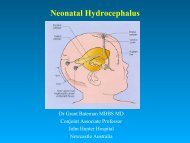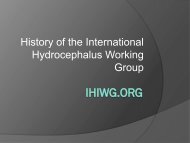Normal-Pressure Hydrocephalus - International Hydrocephalus ...
Normal-Pressure Hydrocephalus - International Hydrocephalus ...
Normal-Pressure Hydrocephalus - International Hydrocephalus ...
- No tags were found...
You also want an ePaper? Increase the reach of your titles
YUMPU automatically turns print PDFs into web optimized ePapers that Google loves.
a. b. c.d. e. f.Figure 2. Images and data obtained in a 77-year-old man (patient 11) with increased CSF flow void; borderline, decreased aqueductal CSFstroke volume (42 p1); and negative response to VP shunting. (a-e) Proton-density-weighted axial spin-echo MR images (3,000/22) demonstratemarked CSF flow (score of 4) through aqueduct and third and fourth ventricles (arrow). (f) Plot of mean velocity (millimeters per second)and volumetric flow rate (cubic millimeters per second) as a function of the cardiac cycle (milliseconds). Velocity is substantially reduced comparedwith that in the patient in Figure 1, who had hyperdynamic flow.an aqueductal CSF stroke volume lessthan 42 .L were considered to havenormal CSF flow and negative CSFflow study findings. Of the 12 patientswith positive study findings, allimproved after CSF diversion; thus,positive predictive value was 100%.Three of the patients with negativeCSF flow study findings respondedpositively to shunting, while threedid not respond; thus, negative predictivevalue was 50%.The sensitivity of the aqueductalstroke volume criteria was 80%, and thespecificity was 100%. Overall accuracywas 83%. These results are summarizedin Tables 2 and 3. Results of a Fisher exacttest performed with the data in Table2 indicate a significant assodation betweenhigh CSF stroke volume and favorablesurgical response (P < .05).As in a previous study (25), all patientswith CSF flow void scores of 2or higher were considered to havehyperdynamic CSF flow and positivestudy findings, while those with ascone of 0 on 1 were considered tohave normal CSF flow and negativestudy findings. Of the 12 patientswith positive findings according tothese criteria, 11 had improvementwith CSF shunting (Fig 1) while onedid not (Fig 2). In contrast, four of thepatients with negative findings hadimprovement while two did not (Fig3). These data are listed in Table 4;there was no statistically significantrelationship between the CSF flowvoid score and response to CSFshunting according to Fisher exacttest results. The sensitivity of usingthese CSF flow void score criteria was73%; specificity, 67%; positive predictivevalue, 92%; and negative predictivevalue, 33%. Overall accuracy was72%. These results are summarized inTable 3.DISCUSSIONThe following conclusions can bedrawn from this study. Positive CSFflow study findings (ie, stroke volumegreater than 42 1iL) are associatedwith an increased likelihood of improvementwith CSF shunting. Positivepredictive value in the patients inthis study was 100%. Negative predictivevalue of the quantitative CSFflow study findings was 50% . Positivepredictive value for the CSF flow voidscore was 92%; thus, when findingsare positive, theme is a reasonable526 #{149} Radiology February 1996








